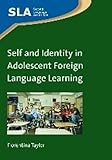Self and Identity in Adolescent Foreign Language Learning / Florentina Taylor.
Material type: TextSeries: Second Language AcquisitionPublisher: Bristol ; Blue Ridge Summit : Multilingual Matters, [2013]Copyright date: ©2013Description: 1 online resource (208 p.)Content type:
TextSeries: Second Language AcquisitionPublisher: Bristol ; Blue Ridge Summit : Multilingual Matters, [2013]Copyright date: ©2013Description: 1 online resource (208 p.)Content type: - 9781847699992
- 9781783090006
- English language -- Study and teaching (Secondary) -- Foreign speakers
- Identity (Psychology)
- Identity (Psychology)
- Interdisciplinary approach in education
- Language and education
- Language arts (Secondary) -- Social aspects
- Second language acquisition
- Teenagers -- Language
- LANGUAGE ARTS & DISCIPLINES / Study & Teaching
- L2 Self
- L2 identity
- SLA
- Second Language Acquisition
- foreign language learning
- foreign language teaching
- identity
- language learnering
- teenage language learners
- the self
- 428.0071/2 23
- P120.Y68 T34 2013
- P120.Y68 T34 2013
- online - DeGruyter
| Item type | Current library | Call number | URL | Status | Notes | Barcode | |
|---|---|---|---|---|---|---|---|
 eBook
eBook
|
Biblioteca "Angelicum" Pont. Univ. S.Tommaso d'Aquino Nuvola online | online - DeGruyter (Browse shelf(Opens below)) | Online access | Not for loan (Accesso limitato) | Accesso per gli utenti autorizzati / Access for authorized users | (dgr)9781783090006 |
Frontmatter -- Contents -- Tables and Figures -- 1. Introduction -- 2. Self and Identity in Adolescence: A Relational Perspective -- 3. Self and Identity in Foreign Language Learning -- 4. A Quadripolar Model of Identity in Adolescent Foreign Language Learning -- 5. Participants’ Self Systems in Four Relational Contexts -- 6. Self Perceptions and Identity Display in Learning English as a Foreign Language -- 7. Of Students and Teachers -- 8. Drawing the Line: Evaluation and Implications -- Appendix A: The L2 Quadripolar Identity Questionnaire -- Appendix B: The L2 Quadripolar Identity Questionnaire with Item Numbers -- Appendix C: Questionnaire Scales with Item Numbers -- Appendix D: Interview guide – Themes Covered, with Examples of Questions and Prompts -- Appendix E: Self System Graphical Representations and Vignettes -- Appendix F: Interviewee Profiles -- Glossary -- References -- Subject Index -- Author Index -- Country Index
restricted access online access with authorization star
http://purl.org/coar/access_right/c_16ec
This book explores the role of identity in adolescent foreign language learning to provide evidence that an identity-focused approach can make a difference to achievement in education. It uses both in-depth exploratory interviews with language learners and a cross-sectional survey to provide a unique glimpse into the identity dynamics that learners need to manage in their interaction with contradictory relational contexts (e.g. teacher vs. classmates; parents vs. friends), and that appear to impair their perceived competence and declared achievement in language learning. Furthermore, this work presents a new model of identity which incorporates several educational psychology theories (e.g. self-discrepancy, self-presentation, impression management), developmental theories of adolescence and principles of foreign language teaching and learning. This book gives rise to potentially policy-changing insights and will be of importance to those interested in the relationship between self, identity and language teaching and learning.
Mode of access: Internet via World Wide Web.
In English.
Description based on online resource; title from PDF title page (publisher's Web site, viewed 01. Dez 2022)


